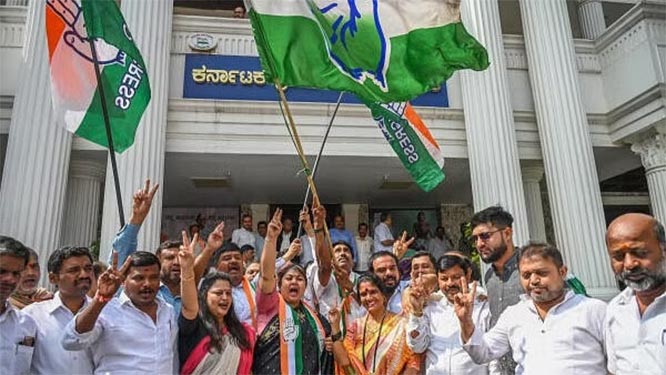Bengaluru: In a boost to the ruling Congress in Karnataka, the party on Saturday swept the by-polls to three Assembly segments, causing a major setback to the BJP-JD(S) alliance in the state.
The Congress has retained Sandur, the seat considered to be its strong hold, and has also bagged Shiggaon and Channapatna segments, which were earlier held by BJP and JD(S) respectively.
The November 13 by-polls to Sandur, Shiggaon and Channapatna Assembly segments had witnessed a fierce fight between the ruling Congress and a combative BJP-JD(S) alliance.
The by-polls to Sandur, Shiggaon and Channapatna were necessitated as the seats fell vacant following the election of their respective representatives -- E Tukaram of Congress, former CM Basavaraj Bommai of BJP, and Union Minister Kumaraswamy of JD(S) to Lok Sabha in May elections.
The by-polls witnessed a straight fight between the ruling Congress and BJP in Sandur and Shiggaon segments, while in Channapatna, JD(S) which is part of the NDA alliance took on the grand old party.
Congress' C P Yogeeshwara won the Channapatna segment, defeating JD(S) candidate and Kumaraswamy's son Nikhil Kumaraswamy, by a margin of 25,413 votes.
Former CM Basavaraj Bommai's son Bharath Bommai of BJP faced defeat against Congress' Yasir Ahmed Khan Pathan in Shiggaon Assembly segment by a margin of 13,448 votes.
In Sandur, Congress candidate E Annapoorna, the wife of Bellary MP E Tukaram, won the seat vacated by her husband, by a margin of 9,649 votes.
Congress' win in the by-poll is seen as an endorsement of both Chief Minister Siddaramaiah and his deputy D K Shivakumar's leadership, and the government's programmes, especially the five guarantee schemes.
Nikhil Kumaraswamy and Bharath Bommai, the third generation of Gowda and Bommai family respectively, who contested this bypolls, have lost. Their fathers and grandfathers had served as Karnataka's Chief Ministers in the past.
While for Bharath Bommai this was his electoral debut, for Nikhil it was his third electoral loss.
Among the three segments, Channapatna was considered to be a high profile battle, where the contest was between C P Yogeeshwara and actor-turned-politician Nikhil Kumaraswamy.
A five-time MLA from the segment and a former Minister, Yogeeshwara had joined the Congress after quitting BJP ahead of nomination.
There were plans to field Yogeeshwara on a JD(S) ticket, but he was not interested in it, and instead wanted Kumaraswamy to support him as BJP candidate. This was not acceptable to Kumaraswamy and his party, following which Yogeeshwara jumped ship.
However, Kumaraswamy had subsequently said he had agreed to Yogeeshwara contesting from BJP, and despite that he jumped ship to Congress, under the influence of Deputy Chief Minister D K Shivakumar and his brother and former MP D K Suresh.
Nikhil had faced defeat in 2019 Lok Sabha and 2023 Assembly polls. It is seen as a setback for Kumaraswamy too, as he could not ensure son's win from the Channapatna, the seat he had twice represented in the past.
Congress' win is crucial for Shivakumar, who is also the state Congress chief and his brother Suresh to strengthen their position in their home district of Ramanagara, a Vokkaliga heartland.
In Shiggaon, BJP's Bharath Bommai, son of Basavaraj Bommai lost against Congress' Yasir Ahmed Khan Pathan, who had faced defeat against the former Chief Minister in the 2023 Assembly polls.
Initially, former MLA Syed Azeempeer Khadri, a Congress' ticket aspirant, had raised a banner of revolt in Shiggaon, by filing his nomination as an independent, but later withdrew after intervention by party leadership.
In Sandur, Bellary MP Tukaram's wife E Annapurna of Congress won from the seat vacated by her husband, against BJP ST Morcha president Bangaru Hanumanthu, who is considered close to party leader and former mining barron G Janardhan Reddy.
Sandur is a Congress' bastion, and Tukaram had represented it four times.
Congress winning the by-polls is seen as "crucial" for Chief Minister Siddaramaiah to assert himself , amid demands for his resignation following charges against him in the MUDA site allotment case.
There were also behind-the-scenes political activities within the ruling Congress earlier this year, with a few ministers in his Cabinet holding closed door meetings, fueling speculation about leadership change. But such activities came to a halt following instructions from the party high command.
It is equally important for Shivakumar, who has not shied away from openly expressing his Chief Ministerial ambitions, amid speculations over "rotational Chief Minister formula," according to which he will become CM after two-and-half years (in this govt's five years tenure), but they have not been officially confirmed by the party.
The defeat in this by-poll is seen as a setback for state BJP President Vijayendra, who has been facing intense criticism and opposition from a section within the party, who have raised a banner of revolt against his leadership accusing him and his father, veteran leader B S Yediyurappa of "adjustment politics".





















Comments
Add new comment